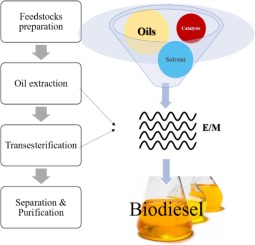当前位置:
X-MOL 学术
›
Renew. Energy
›
论文详情
Our official English website, www.x-mol.net, welcomes your
feedback! (Note: you will need to create a separate account there.)
Intensification of Reutealis trisperma biodiesel production using infrared radiation: Simulation, optimisation and validation
Renewable Energy ( IF 9.0 ) Pub Date : 2019-04-01 , DOI: 10.1016/j.renene.2018.10.023 A.S. Silitonga , T.M.I. Mahlia , F. Kusumo , S. Dharma , A.H. Sebayang , R.W. Sembiring , A.H. Shamsuddin
Renewable Energy ( IF 9.0 ) Pub Date : 2019-04-01 , DOI: 10.1016/j.renene.2018.10.023 A.S. Silitonga , T.M.I. Mahlia , F. Kusumo , S. Dharma , A.H. Sebayang , R.W. Sembiring , A.H. Shamsuddin

|
Abstract Biodiesel production using intensification of methyl ester is becoming very important due to its considerably lower energy requirement and shorter reaction time in obtaining feedstock oil. The present study investigated utilisation of Reutealis trisperma oil to produce biodiesel. A Box-Behnken experimental design was used to optimise the transesterification process. The process variables were explored and the optimum methanol to oil molar ratio, catalyst concentration, reaction temperature, and reaction time were 8:1, 1.2 wt%, 64 °C and 68 min respectively and the corresponding methyl ester yield was 98.39%. The experiment was conducted in triplicate to validate the quadratic model. Results showed average methyl ester yield was 97.78%, which is close to the predicted value, indicating reliability of the model. Results also indicated that using infrared radiation method has many advantageous, such as less energy consumption as a result of deeper penetration of reactant mass which can improve mass transfer between the immiscible reactants in order to improve quality of biodiesel. The physicochemical properties of Reutealis trisperma methyl ester produced under optimum transesterification process variables were also measured and the properties fulfilled the fuel specifications as per ASTM D6751 and EN 14214 standards.
中文翻译:

使用红外辐射强化 Reutealis trisperma 生物柴油生产:模拟、优化和验证
摘要 使用甲基酯强化生产生物柴油正变得非常重要,因为它在获得原料油时的能量需求显着降低,反应时间更短。本研究调查了利用 Reutealis trisperma 油生产生物柴油。Box-Behnken 实验设计用于优化酯交换过程。探索了工艺变量,最佳甲醇油摩尔比、催化剂浓度、反应温度和反应时间分别为8:1、1.2wt%、64℃和68min,相应的甲酯产率为98.39%。该实验一式三份进行以验证二次模型。结果表明,平均甲酯产率为97.78%,接近预测值,表明模型的可靠性。结果还表明,使用红外辐射方法具有许多优点,例如由于反应物质量渗透更深,可以减少能量消耗,可以改善不混溶反应物之间的传质,从而提高生物柴油的质量。还测量了在最佳酯交换过程变量下生产的三叶草甲酯的物理化学性质,这些性质符合 ASTM D6751 和 EN 14214 标准的燃料规格。
更新日期:2019-04-01
中文翻译:

使用红外辐射强化 Reutealis trisperma 生物柴油生产:模拟、优化和验证
摘要 使用甲基酯强化生产生物柴油正变得非常重要,因为它在获得原料油时的能量需求显着降低,反应时间更短。本研究调查了利用 Reutealis trisperma 油生产生物柴油。Box-Behnken 实验设计用于优化酯交换过程。探索了工艺变量,最佳甲醇油摩尔比、催化剂浓度、反应温度和反应时间分别为8:1、1.2wt%、64℃和68min,相应的甲酯产率为98.39%。该实验一式三份进行以验证二次模型。结果表明,平均甲酯产率为97.78%,接近预测值,表明模型的可靠性。结果还表明,使用红外辐射方法具有许多优点,例如由于反应物质量渗透更深,可以减少能量消耗,可以改善不混溶反应物之间的传质,从而提高生物柴油的质量。还测量了在最佳酯交换过程变量下生产的三叶草甲酯的物理化学性质,这些性质符合 ASTM D6751 和 EN 14214 标准的燃料规格。











































 京公网安备 11010802027423号
京公网安备 11010802027423号